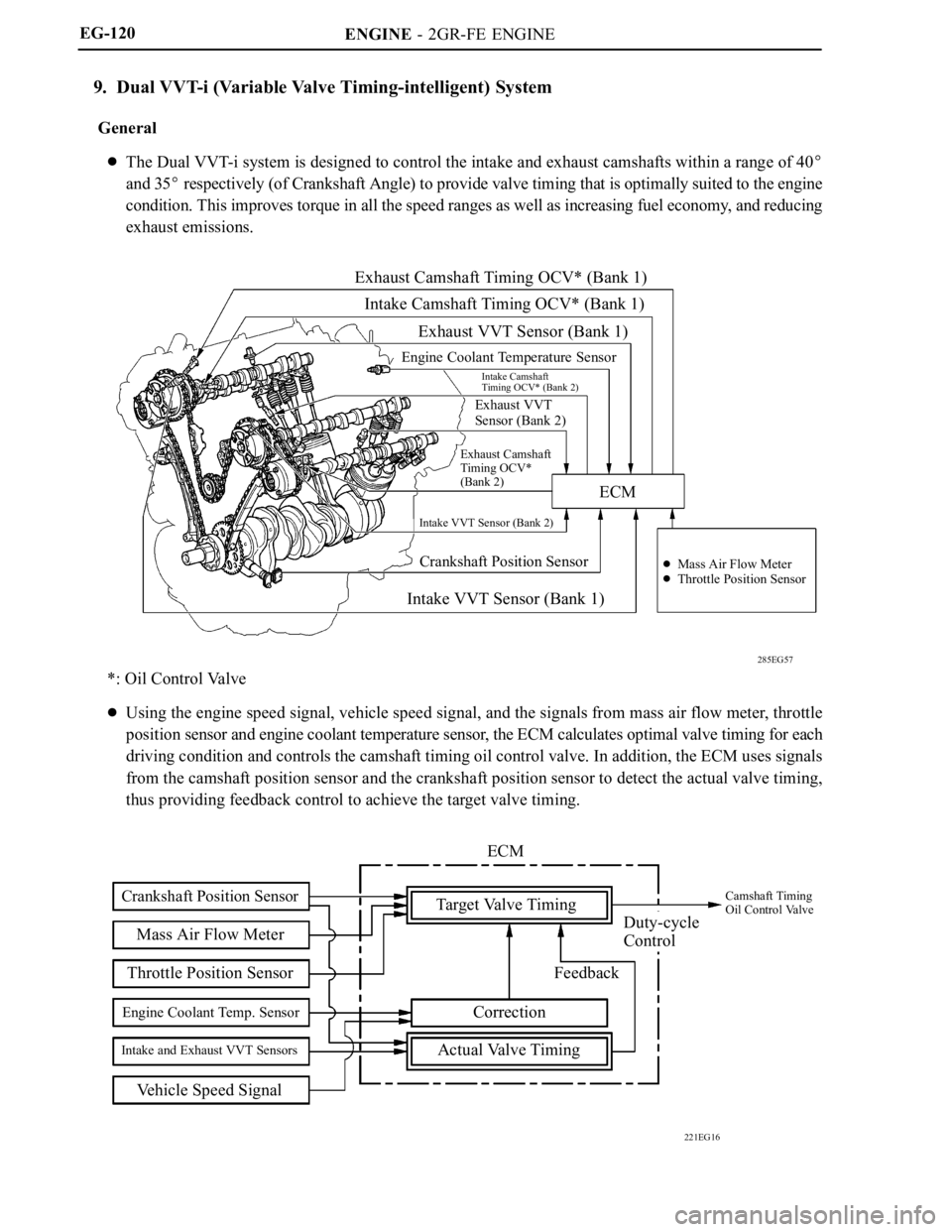torque TOYOTA RAV4 2006 Service Repair Manual
[x] Cancel search | Manufacturer: TOYOTA, Model Year: 2006, Model line: RAV4, Model: TOYOTA RAV4 2006Pages: 2000, PDF Size: 45.84 MB
Page 24 of 2000

ENGINE - 2AZ-FE ENGINE
01NEG46Y
ArmatureSurface Commutator
Permanent Magnet
Brush
LengthEG-27
STARTING SYSTEM
1. General
A compact and lightweight PS (Planetary reduction-Segment conductor motor) type starter is used.
Because the PS type starter contains an armature that uses square-shaped conductors, and its surface
functions as a commutator, it has resulted in both improving its output torque and reducing its overall
length.
In place of the field coil used in the conventional type starter, the PS type starter uses two types of
permanent magnets: main magnets and interpolar magnets. The main magnets and interpolar magnets
have been efficiently arranged to increase the magnetic flux and to shorten the length of the yoke.
Specifications
Starter TypePS Type
Rating Output1.7 kW
Rating Voltage12 V
Length*1mm (in.)128 (5.04)
Weight g (lb)2950 (6.50)
Rotational Direction*2Counterclockwise
*1: Length from the mounted area to the rear end of the starter
*
2: Viewed from pinion side
Page 25 of 2000

ENGINE - 2AZ-FE ENGINE
206EG20
Conventional Type
A - A
Cross Section
(PS Type)B - B
Cross Section
(Conventional Type)
B
B
A
A Armature
ArmatureBrushCommutator Brush
Surface CommutatorSquare-shaped
ConductorRound-shaped
Conductor
PS Type
222EG15
Main Magnet
Interpolar Magnet
Yo k e
Main Magnet
Armature
Cross Section of YokeMagnetic Flux Generated by
Relationship between Main Magnets
Magnetic Flux Generated
by Interpolar Magnets
N
N
N
S
S
S EG-28
2. Construction
Instead of constructing the armature coil with conventional type round-shaped conductor wires, the PS
type starter uses square conductors. With this type of construction, the same conditions that are realized
by winding numerous round-shaped conductor wires can be achieved without increasing the mass. As a
result, the output torque has been increased, and the armature coil has been made more compact.
Because the surface of the square-shaped conductors that are used in the armature coil functions as a
commutator, the overall length of the PS type starter has been shortened.
Instead of the field coils used in the conventional type starter, the PS type starter uses two types of
permanent magnets: the main magnets and the interpolar magnets. The main and interpolar magnets are
arranged alternately inside the yoke, allowing the magnetic flux that is generated between the main and
interpolar magnets to be added to the magnetic flux that is generated by the main magnets.
In addition to increasing the amount of magnetic flux, this construction shortens the overall length of the
yoke.
Page 45 of 2000

ENGINE - 2AZ-FE ENGINE
DR011EG25
Camshaft Position Sensor
Engine Coolant
Temperature Sensor
Crankshaft
Position Sensor
Camshaft Timing
Oil Control Valve
Throttle Position
Sensor
ECM
Mass Air Flow Meter Vehicle Speed Signal
221EG16
Crankshaft Position Sensor
Mass Air Flow Meter
Throttle Position Sensor
Engine Coolant Temp. Sensor
Camshaft Position Sensor
Vehicle Speed SignalECM
Target Valve Timing
Feedback
Correction
Actual Valve Timing
Duty-cycle
Control
Camshaft Timing
Oil Control Valve
EG-48
7. VVT-i (Variable Valve Timing-intelligent) System
General
The VVT-i system is designed to control the intake camshaft within a range of 40 (of Crankshaft Angle)
to provide valve timing that is optimally suited to the engine condition. This realizes proper torque in
all the speed ranges as well as realizing excellent fuel economy, and reducing exhaust emissions.
Using the engine speed signal, vehicle speed signal, and the signals from mass air flow meter, throttle
position sensor and engine coolant temperature sensor, the ECM can calculate optimal valve timing for
each driving condition and controls the camshaft timing oil control valve. In addition, the ECM uses
signals from the camshaft position sensor and crankshaft position sensor to detect the actual valve timing,
thus providing feedback control to achieve the target valve timing.
Page 46 of 2000

ENGINE - 2AZ-FE ENGINE
185EG48
185EG49
185EG50
287EG34
185EG48
185EG48
TDCLatest Timing
EX IN
BDC
To Advance Side
EX IN
EX IN
To Advance Side
EX IN
To Retard Side
Latest Timing
EX IN
Latest Timing
EX INEG-49
Effectiveness of the VVT-i System
Operation State
ObjectiveEffect
During Idling
At Light Load
Minimizing overlap to
reduce blowback to the
intake sideStabilized idling rpm
Better fuel economy
At Medium Load
Increasing overlap
increases internal EGR,
reducing pumping lossBetter fuel economy
Improved emission
control
In Low to Medium
Speed Range with
Heavy LoadAdvancing the intake
valve close timing for
volumetric efficiency
improvement
Improved torque in low
to medium speed range
In High Speed Range
with Heavy Load
Retarding the intake
valve close timing for
volumetric efficiency
improvement
Improved output
At LowTemperature
Minimizing overlap to
prevent blowback to
the intake side leads to
the lean burning
condition, and
stabilizes the idling
speed at fast idle
Stabilized fast
idle rpm
Better fuel economy
Upon Starting
Stopping the
Engine
Minimizing overlap to
minimize blowback to
the intake side
Improved startability
Page 66 of 2000

ENGINE - 2AZ-FE ENGINE
01MEG02Y
Valve Timing : Intake Valve Opening Angle
: Exhaust Valve Opening Angle
VVT-i Operation
Range
VVT-i Operation
RangeTDC
3
3
43
65
25
45
BDCEG-3
Engine Specifications
No. of Cyls. & Arrangement4-cylinder, In-line
Valve Mechanism16-valve DOHC, Chain Drive (with VVT-i)
Combustion ChamberPentroof Type
ManifoldsCross-flow
Fuel SystemSFI
Ignition SystemDIS
Displacement cm3 (cu. in.)2362 (144.1)
Bore x Stroke mm (in.)88.5 x 96.0 (3.48 x 3.78)
Compression Ratio9.8 : 1
Max. Output*1(SAE-NET)124 kW @ 6000 rpm (166 HP @ 6000 rpm)
Max. Torque*1(SAE-NET)224 N.m @ 4000 rpm (165 ft-lbf @ 4000 rpm)
IntakeOpen3 - 43 BTDC
Valve Timing
IntakeClose65 - 25 ABDCVa l v e T i m i n g
ExhaustOpen45 BBDCExhaustClose3 ATDC
Firing Order1 - 3 - 4 - 2
Research Octane Number91 or higher
Octane Rating87 or higher
Oil GradeILSAC
Tailpipe Emission RegulationULEV-II, SFTP
Evaporative Emission RegulationLEV-II, ORVR
Engine Service Mass*2 (Reference) kg (lb)138 (304.2)
*1: Maximum output and torque rating is determined by revised SAE J1349 standard.
*
2: Weight shows the figure with oil and water fully filled.
Page 116 of 2000

ENGINE - 2GR-FE ENGINE
285EG57
Exhaust Camshaft Timing OCV* (Bank 1)
Intake Camshaft Timing OCV* (Bank 1)
Exhaust VVT Sensor (Bank 1)
Engine Coolant Temperature Sensor
Intake Camshaft
Timing OCV* (Bank 2)
Exhaust VVT
Sensor (Bank 2)
Exhaust Camshaft
Timing OCV*
(Bank 2)
Intake VVT Sensor (Bank 2)
Crankshaft Position Sensor
Intake VVT Sensor (Bank 1)ECM
Mass Air Flow MeterThrottle Position Sensor
221EG16
Crankshaft Position Sensor
Mass Air Flow Meter
Throttle Position Sensor
Engine Coolant Temp. Sensor
Intake and Exhaust VVT Sensors
Vehicle Speed SignalECM
Ta r g e t Va l v e Ti m i n g
Feedback
Correction
Actual Valve Timing
Duty-cycle
Control
Camshaft Timing
Oil Control Valve
EG-120
9. Dual VVT-i (Variable Valve Timing-intelligent) System
General
The Dual VVT-i system is designed to control the intake and exhaust camshafts within a range of 40
and 35 respectively (of Crankshaft Angle) to provide valve timing that is optimally suited to the engine
condition. This improves torque in all the speed ranges as well as increasing fuel economy, and reducing
exhaust emissions.
*: Oil Control Valve
Using the engine speed signal, vehicle speed signal, and the signals from mass air flow meter, throttle
position sensor and engine coolant temperature sensor, the ECM calculates optimal valve timing for each
driving condition and controls the camshaft timing oil control valve. In addition, the ECM uses signals
from the camshaft position sensor and the crankshaft position sensor to detect the actual valve timing,
thus providing feedback control to achieve the target valve timing.
Page 117 of 2000

ENGINE - 2GR-FE ENGINE
285EG62 285EG61 285EG60
285EG63
285EG59
285EG59 285EG59
Earliest Timing
(EX)Latest Timing
(IN)TDC
EX IN
BDC
To Advance
Side (EX)To R e t a r d
Side (IN)
EX IN
To Advance
Side (IN)To R e t a r d
Side (EX)
EX IN
EX IN
EX IN
To Retard
Side (EX)To Advance
Side (IN)
To R e t a r d
Side (IN)To A d v a n c e
Side (EX)
Earliest Timing
(EX)Latest Timing
(IN)
Earliest Timing
(EX)Latest Timing
(IN)
EX IN
EX IN
EG-121
Effectiveness of the VVT-i System
Operation State
ObjectiveEffect
During Idling
Eliminating overlap to
reduce blow back to the
intake side.Stabilized idling rpm
Better fuel economy
At Light Load
Eliminating overlap to
reduce blow back to the
intake side.
Ensured engine stability
At Medium Load
Increasing overlap
increases internal EGR,
reducing pumping loss.Better fuel economy
Improved emission
control
In Low to
Medium Speed
Range with
Heavy LoadAdvancing the intake
valve close timing for
volumetric efficiency
improvement.
Improved torque in low
to medium speed range
In High Speed
Range with
Heavy LoadRetarding the intake
valve close timing for
volumetric efficiency
improvement.
Improved output
At Low
Temperatures
Eliminating overlap to
reduce blow back to the
intake side leads to the
lean burning condition,
and stabilizes the idling
speed at fast idle.
Stabilized fast idle
rpm
Better fuel economy
Upon Starting
Stopping the
Engine
Eliminating overlap to
minimize blow back to
the intake side.
Improved startability
Page 118 of 2000

ENGINE - 2GR-FE ENGINE
271EG93
Timing RotorHousingLock PinSprocket
Intake Camshaft
Vane (Fixed on Intake Camshaft)
Oil Pressure
In Operation At a Stop
Lock Pin
281EG47
Housing
Advanced Angle Assist SpringVane (Fixed on Exhaust Camshaft)Lock PinExhaust Camshaft Sprocket EG-122
Construction
1) VVT-i Controller
This controller consists of the housing driven by the timing chain and the vane coupled with the intake
and exhaust camshafts.
The intake side uses a VVT-i controller with 3 vanes, and the exhaust side uses one with 4 vanes.
When the engine stops, the intake side VVT-i controller is locked on the most retarded angle side by
the lock pin, and the exhaust side VVT-i controller is locked on the most advanced angle side. This
ensures excellent engine startability.
The oil pressure sent from the advance or retard side path at the intake and exhaust camshaft causes
rotation in the VVT-i controller vane circumferential direction to vary the intake valve timing
continuously.
An advanced angle assist spring is provided on the exhaust side VVT-i controller. This helps to apply
torque in the advanced angle direction so that the vane lock pin securely engages with the housing
when the engine stops.
Intake Side VVT-i Controller
Exhaust Side VVT-i Controller
Page 131 of 2000

ENGINE - 2GR-FE ENGINEEG-69
Engine Specifications
No. of Cyls. & Arrangement6-cylinder, V Type
Valve Mechanism24-valve DOHC, Chain Drive (with Dual VVT-i)
Combustion ChamberPentroof-type
ManifoldsParallel-flow
Fuel SystemSFI
Ignition SystemDIS
Displacement cm3
(cu. in.)3456 (210.9)
Bore x Stroke mm (in.)94.0 x 83.0 (3.70 x 3.27)
Compression Ratio10.8 : 1
Max. Output (SAE-NET)*1201 kW @ 6200 rpm (269 HP @ 6200 rpm)
Max. Torque (SAE-NET)*1333 N.m @ 4700 rpm (247 ft.lbf @ 4700 rpm)
Intake ValveOpen-3 to 37 BTDC
Valve Timing
Intake ValveClose71 to 31 ABDCVa l v e T i m i n g
Exhaust ValveOpen60 to 25 BBDCExhaust ValveClose4 to 39 ATDC
Firing Order1 - 2 - 3 - 4 - 5 - 6
Octane Rating91 or higher
Engine Oil GradeILSAC multigrade engine oil
CaliforniaULEVII, SFTP
EmissionTailpipeExceptTier2 Bin5 SFTPEmission
Regulation
ppExcept
CaliforniaTier2-Bin5, SFTPg
EvaporativeLEVII, ORVR
Engine Service Mass*2 (Reference) kg (lb)163 (359)
*1: Maximum output and torque rating is determined by revised SAE J1349 standard.
*
2: Weight shows the figure with the oil and engine coolant fully filled.
Page 133 of 2000

CHASSIS - 4WD SYSTEM CH-66
4WD SYSTEM
DESCRIPTION
The 4WD system of the ’06 RAV4 uses an active torque control 4WD system.
It is a compact, lightweight, and high performance 4WD system that optimally controls the torque
distribution to the front and rear wheels through the electric control coupling in the rear differential.
ACTIVE TORQUE CONTROL 4WD SYSTEM
1. General
Based on information provided by various sensors, the 4WD ECU controls the amperage that is applied
to the electric control coupling, in order to transmit drive torque to the rear wheels when needed, and in
the amount needed. The following describes the features of the active torque control 4WD system.
Traction performance
Realizes stable start-off and acceleration performance
Driving stability performanceRealizes stable cornering performance
Fuel economyRealizes better fuel economy by transmitting drive torque to the rear
wheels when needed, in the amount needed.
A four-wheel drive lock switch has been provided. This enables the driver to select between the AUTO
and LOCK modes by operating the switch. The system optimally controls the torque distribution to the
front and rear wheels in the respective modes.
Mode
Four-wheel Drive
Lock Switch and
Indicator Light
Outline
AUTOOFF
Optimally distributes drive torque to the front and rear wheels.
Ensures optimal start-off performance during a start-off, based on
information provided by various sensors.
Suppresses the tight corner braking phenomenon* during low-speed
cornering.
Reduces the amount of torque distribution to the rear wheels and
improves fuel economy when the system judges that the vehicle is
traveling steadily.
Disengages the 4WD during braking deceleration.
LOCKON
Distributes the maximum torque limit to the rear wheels.
Distributes the maximum torque limit to the rear wheels during
start-off.
Distributes optimal torque during low-speed cornering.
Disengages the 4WD during braking deceleration.
Disengages the LOCK mode and transfers to the AUTO mode when
the vehicle speed exceeds 40 km / h (25 mph).
*: Tight corner braking phenomenon: a condition in which the brakes are applied due to a rotational difference
between the front and rear wheels, such as during low-speed cornering in the 4WD mode.
The 4WD ECU effects cooperative control with the skid control ECU, in order to control the drive torque
distribution to the front and rear wheels in accordance with information received from the skid control
ECU. These controls ensure a smooth acceleration and driving stability.